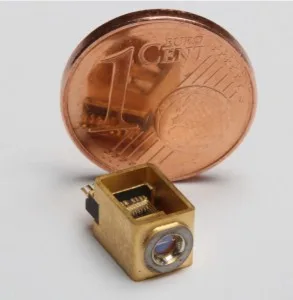TriLite Technologies (Vienna, Austria) is a start-up that has been working on a unique laser display technology for about four years. Now, the company is ready to tell the world about its inventions.
There are two technologies the company is announcing at next month’s Photonics West. One is the TriLite RGB laser module that can be used in pico projectors, VR/AR headsets, HUDs and other products. The other, called the TriLite Trixel, uses this RGB laser module, optics and a 1-axis MEMS mirror to create a “steerable pixel”. A display is then created by assembling a number of these Trixels into an array.
The Trixel includes an FAC (fast axis collimating) lens in front of the lasers to create a line of red, green and blue light. These are then swept through space by the 1-axis scanning mirror, allowing the pixel light to be steered over the viewing space.
A steerable pixel can enable several applications. The most obvious is a glasses-free 3D display that directs left and right eye images to specific points in the viewer space. It does this by using the MEMS mirror to sweep the viewer space from right to left. Stand in any of the sweet spots over 40-degree field of view and you will see a stereoscopic image.
Another use is to create multiple 2D images that are visible at different points in the viewing cone. Think of a road sign that displays one set of information to lane 1 and different information to lane 2.
 TriLite Trixel Red Laser 3×5 Prototype
TriLite Trixel Red Laser 3×5 Prototype
In general, TriLite CEO Ferdinand Saint Julien thinks the Trixel is best targeted at outdoor and large area digital signage for advertising and retail, public screening, digital traffic management, stadium screen, arenas and shopping malls. While the module is small, it is not tiny and results in displays with a rather large 18mm pixel pitch, which means viewers need to be some distance away to get an image that is not too pixelated. However, the display can be very bright – up to 30K nits, says TriLite, with an overall viewing angle of 40 (H) x 20 (V) degrees, and is hence targeting the large-scale outdoor signage market.
A year and a half ago, the company had a red-only laser demo, but now it is building an RGB demo. The biggest array TriLie has made to date is small – 5×3 pixels, but the second display prototype based on RGB is in development that will go to 108 pixels
The second technology the company is releasing is its RGB laser module. This also includes a GaAs red laser plus blue and green lasers made from GaN. The company adds slow axis collimator (SAC) optics to combine the red green and blue light into 3 beam dots. When packaged with a 2-axis MEMS mirror, the light is now easily swept in two directions by the mirror. TriLite has some novel IP around how to create an image using a 2-axis MEMS mirror.
TriLite will also offer this RGB laser module to OEM customers for integration with their own scanning systems to build pico projectors or other products.
The RGB laser module is just 9.1 x 5.5 x 5.3 mm and weighs just 1.5 grams, making the light source extremely suitable for embedding in portable devices. Company CTO, Dr. Franz Fidler noted that, “With the further reduction of size, TriLite’s RGB laser module opens up the possibility of virtual reality smart glasses projecting image information directly into the wearer’s eyes, and smartphones as well as smart watches that feature embedded pico projectors”.
Other potential uses could be head-up displays, stage lighting, automotive headlights and more.
TriLite wants to be a component specialist working with other supply chain partners for mass production of these products and technologies. That means developers can use the integrated Trixel module to create displays, or, they can use the RGB laser module in combination with a scanner of their choosing to create products as they see fit. The laser module is packaged in a newly fabricated hermetic package, and additional validation work is currently ongoing. Any product level solution will also have to deal with de-speckling and eye safety.
Trilite says it now wants to engage with strategic partners to advance the commercialization.
Both products will be demonstrated at the Photonics West 2015 exhibition, February 10th to 12th 2015 in San Francisco, CA, USA. – Chris Chinnock

